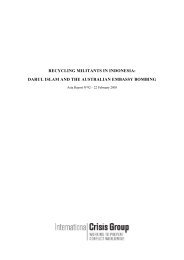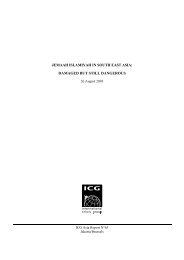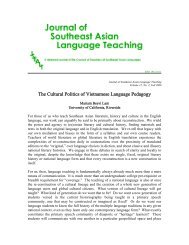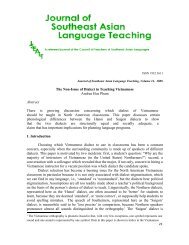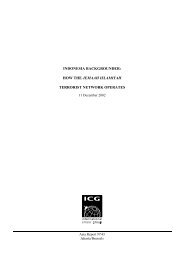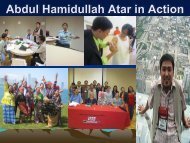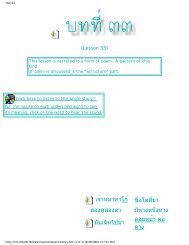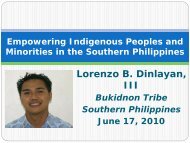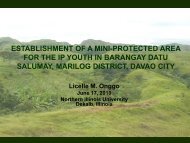Introduction - SEAsite - Northern Illinois University
Introduction - SEAsite - Northern Illinois University
Introduction - SEAsite - Northern Illinois University
Create successful ePaper yourself
Turn your PDF publications into a flip-book with our unique Google optimized e-Paper software.
Prentation Abstracts<br />
ferentiation of fields leading to integration as well as diversification. From this<br />
perspective, Lao social structure forms a system in itself and part of regional and<br />
global structures. To analyze current changes in Lao social structure, the evolution<br />
of social fields has to be understood in global and local terms. The agents’<br />
position within the structure depends on the value of their social capital on the<br />
emerging fields in Lao society. Two dimensions have to be added to Bourdieu’s<br />
concept. First, social structure cannot be reduced to differences in capital alone but<br />
is shaped by cultural patterns of action as well. Second, historical differences and<br />
patterns still persist (somewhat covertly). The elements of these dimensions form<br />
a specific configuration, which might be called a socio-cultural structure. In Laos,<br />
we can determine the emergence of two main fields (economic and political) – as<br />
in Western countries. On these fields, agents adhere to cultures of patrimonialism<br />
(Ernst Boesch), subsistence ethics (James Scott), occasionalism and rationalism<br />
(Max Weber), while differing in their possibilities of action. These are changing<br />
due to global, regional, and local tendencies. The paper is to present the most important<br />
aspects of the relation between resources, current tendencies and cultures<br />
on the economic and political fields.<br />
Mary Riley*, Gregg R. Dietzman4**** Bounhong Southavong***,<br />
Marian Kadushin**, Kongmany Sydara***, Amey Libman1, Somsanith<br />
Bouamanivong***, Charlotte Gyllenhaal1, Doel<br />
Soejarto1.<br />
The Lao Traditional Medicine Mapping Project (Lao TMMP)<br />
<strong>Illinois</strong><br />
*Program for Collaborative Research in the Pharmaceutical Sciences (PCRPS),<br />
College of Pharmacy, <strong>University</strong> of <strong>Illinois</strong> at Chicago, 833 S. Wood St., Chicago,<br />
IL 60612 and **Department of Botany, Field Museum, 1400 S. Lake Shore Drive,<br />
Chicago, IL 60605, USA<br />
***Traditional Medicine Research Center, Ministry of Health, Vientiane, Lao<br />
People’s Democratic Republic<br />
****White Point Systems, Inc., 120 Nichols St., Friday Harbor, WA 98250<br />
Because research involving the use of traditional knowledge and access to<br />
genetic resources triggers intellectual property concerns, the UIC ICBG has established<br />
the Lao Traditional Medicine Mapping Project (Lao TMMP) in order<br />
to organize, catalogue, and ultimately recognize and protect the intellectual property<br />
embedded in the knowledge and practices used by traditional healers in Lao<br />
traditional medicine. This paper will: (1) outline the objectives the Lao TMMP<br />
serves to meet; (2) briefly discuss the issues involved in the intellectual property<br />
protection of traditional knowledge; (3) discuss the formal and informal means to<br />
be used to protect Lao traditional medicinal knowledge. The overall goal of the<br />
Lao TMMP is to recognize the value of, protect, and promote traditional medicine<br />
in Laos, and to assist the TMRC its mission to encourage traditional medicine use<br />
among the Lao population, especially in rural areas.<br />
William G. Robichaud<br />
Testing assumptions: the recent history of forest cover in<br />
Nakai-Nam Theun National Protected Area, Khammouan<br />
and Bolikhamxay Provinces<br />
Centre for Biodiversity Research, <strong>University</strong> of British Columbia, Vancouver, BC,<br />
CANADA<br />
Nakai-Nam Theun National Protected Area (NNT NPA), in the Annamite<br />
Mountains of central Laos, is the largest nature reserve in Laos or Vietnam. It has<br />
witnessed a flurry of management planning in recent years, largely as precondition<br />
for the World Bank’s consideration of support for the nearby Nam Theun 2 dam.<br />
A pillar of NNT’s management planning - and which permeates most protected<br />
area planning in Laos - has been that swidden agriculture is the principal threat to<br />
the area’s forest cover, and thus interventions in indigenous agricultural systems<br />
the first priority of management. However, in NNT the magnitude of the swidden<br />
‘problem’ is an untested assumption, since there has never been an analysis of<br />
trends in forest cover in the reserve. This study attempted to fill that gap using,<br />
as a first step, analyses of decades-long series of topographic maps and Landsat<br />
satellite imagery.<br />
Results show that there was probably a significant decline in forest cover in<br />
NNT from the mid-1960s to the early 1980s, but that in the last two decades forest<br />
cover has been stable, and perhaps increased slightly. But even in the earlier period<br />
of loss, the broad area over which local residents cleared fields has not grown<br />
- what loss occurred was largely a process of infilling and intensification within<br />
the boundaries of a forest/swidden mosaic, rather than expansion outward into untrammeled<br />
areas of the reserve. Reasons for this probably include cultural stability<br />
and conservatism, and argue for a more conservative management approach.<br />
Yokoyama Satoshi, Ph.D.<br />
The Trade Flow of Agro-forest Products and Commodities<br />
in <strong>Northern</strong> Mountainous Region of Laos<br />
Rural Geography, Associate Professor, Faculty of Letters, Kumamoto <strong>University</strong>,<br />
Japan<br />
This study focuses on the mountainous region of Ngoi district in Luang Phabang<br />
province, where three ethnic groups, the Lao, the Khmu and the Hmong, reside<br />
in the same area. In this area, people have gathered forest products for export<br />
since the 1990s. There is a long history of forest product gathering in northern<br />
Laos. The indigenous peoples, especially Khmu people, have actively gathered<br />
benzoin and cardamom for centuries. In the past, governmental peddlers had sold<br />
merchandise and purchased agro-forest products from mountain people. After the<br />
Lao version of Perestroika or “Chintanakan Mai” in 1986, privately managed general<br />
stores and periodic markets appeared on the Ou riverside.<br />
In an ethnic Lao village along the Ou river, seven households have opened<br />
general stores since 1985, and by 2003 a total of 15 households were running<br />
general stores. These merchants engage in both commodity sales and agro-forest<br />
products trading. After the middle 1990s, agro-forest traders appeared in Khmu<br />
and Hmong settlements in this mountainous region in addition to the Lao village.<br />
The periodic markets are held once every 10 days. Many market stalls and traders<br />
come from outside the study area, and mountain people also walk down to the<br />
market place from the mountainous area carrying forest products over their shoulders.<br />
Forest products, except for benzoin and cardamom that are traded in this<br />
region are not traditional species as food or medicine but new species exported to<br />
China after the 1990s. What amazes us is that gatherers and traders do not know<br />
the intended use of new forest products in China, that is, local people have little<br />
interest in these species.<br />
The Thailand border at Houay Xai and the Chinise border at Boten in northern<br />
Laos, which were closed to ordinary people due to governmental policy, were<br />
re-opened in the early of 1990s. Afterwards, some Chinese traders directly came<br />
to northern Laos by truck to purchase these forest products. Additionally, a number<br />
of Chinese merchants opened stalls dealing in electrical products and tools<br />
at these periodic markets. The flow of people, goods and information seen after<br />
“Chintanakan Mai” have strongly influenced the occupational structure of these<br />
mountain peoples.<br />
Souksomboun Sayasithsena<br />
Contemporary Lao Writing<br />
Foreign Service Institute, US Department of State, Washington, D.C.<br />
Lao writing evolved through times, from pure Pali to modified Pali-Lao. This<br />
occurred in the Wat or temple schools. In this presentation I will focus on the<br />
period of from late 1950’s until present. Discussion will cover variety of ways<br />
of how people conceptualize the Lao writing system. These three major writings:<br />
from the sound of words; the Royal Decree No. 10, in late 1950’s which included<br />
a set of rules; and a textbook by Mr. Phoumi Vongvichit, after 1975 which simplified<br />
each syllable spelling to a vowel and initial consonant with or without final.<br />
Some points on Lao alphabet charts will be mentioned: the new “sara IA” and the<br />
omission of “Ror”. And what happened since.<br />
I will also discuss the extend to which the spelling of Lao words varies? This<br />
includes Lao-Nork vs. Lao-Nai spellings. Is it possible for the readers to instantly<br />
distinguish between the two? What is the reaction of readers to the two systems?<br />
State-of-the art texts – the use of variety of Lao fonts in computers has made<br />
a big difference. Some examples will be presented to illustrate how typists tried to<br />
cope with columns and justified texts. I will also talk about some difficulties my<br />
Lao students have encountered when they use Lao-English dictionaries?<br />
Punctuation is another issue that I will discuss. Some samples will accompany<br />
points of discussion.<br />
Some grammar points will be discussed along with some features of Laoway<br />
of speaking, such as stressing, repeating of words, and some Tong Toi.






